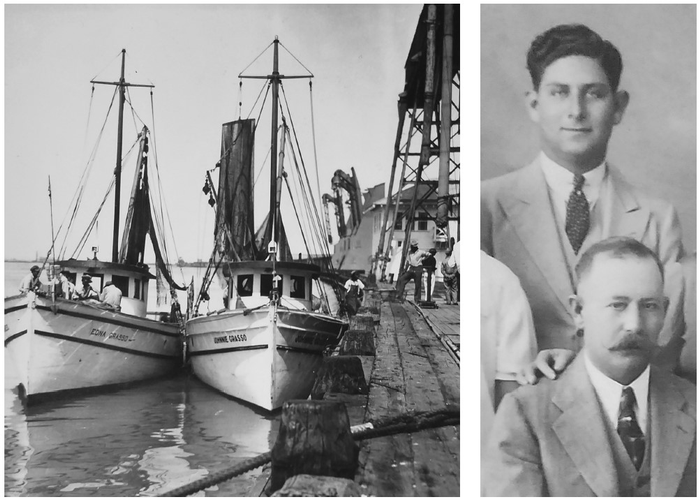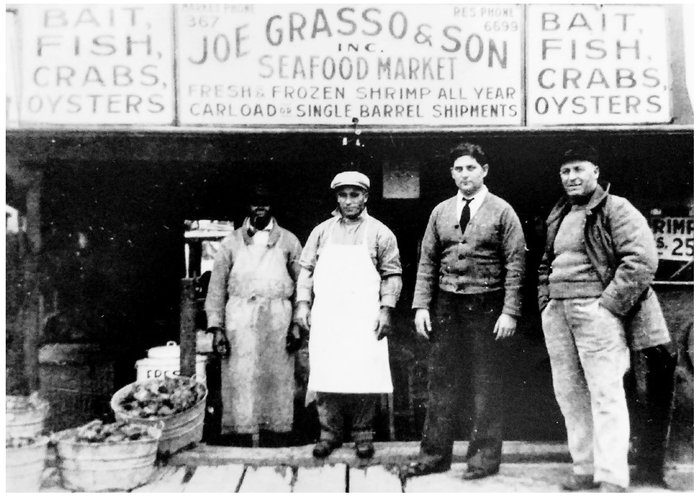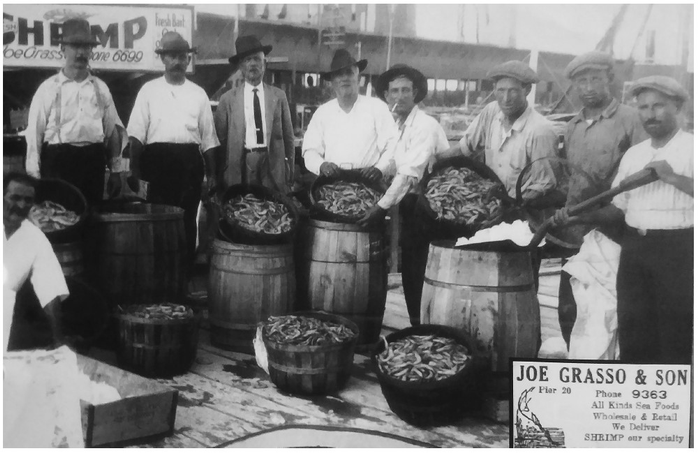Like layers
of an onion being peeled back one by one, there is always more to be revealed
about Galveston,
its people, its places, and even its food. Consider shrimp - not which dish is best,
but rather the history behind it, the men who dreamed of it and devoted their
lives to it.
At one time, a father and son duo sold the
common shrimp and masterfully created an empire, claiming their own place in Galveston history. This
is the story of Joseph Grasso and Son, one of Galveston’s largely forgotten success
stories.
A yellowed newspaper clipping from the 1950s
shows Joseph Grasso Jr. kneeling next to two brown pelicans. The story explains
the odd picture - Grasso had been chosen by the Texas
governor to procure some wild pelicans for Buckingham Palace
at the request of Her Majesty, the Queen of England.
Such was the celebrity of businessman Joe
Grasso Jr. in the latter years of his life. A friend of politicians and the
media as well as an extraordinary businessman, Joseph Grasso Jr. was only the
second act of a greater father and son story. It did not begin with
high-powered friends of influence, but as the survival story of a humble
immigrant, Joseph Grasso senior, who just wanted to sell shrimp.
In the years following the great storm of
1900, Galveston
tenaciously rebuilt, and then it reemerged with a new look and a slightly
different complexion. New people arrived to fill the void of those lost to the
disastrous storm. Exotic new names and faces arrived from places like Greece, Italy,
Serbia,
and other southern European lands. With them, they brought to the island their
unique cultural distinctions.
 In
1906, Joseph Grasso emigrated from Italy at just 23 years of age. He
arrived with little money and few skills. Soon he found himself amid a
simmering melting pot of fresh immigrants, all in the same struggle of surviving
in this unfamiliar land through whatever hopeful means possible. In Galveston in the 1900s,
often this meant laboring on the wharves as a longshoreman or working the bays
as a fisherman's hand. This is where young Grasso landed.
In
1906, Joseph Grasso emigrated from Italy at just 23 years of age. He
arrived with little money and few skills. Soon he found himself amid a
simmering melting pot of fresh immigrants, all in the same struggle of surviving
in this unfamiliar land through whatever hopeful means possible. In Galveston in the 1900s,
often this meant laboring on the wharves as a longshoreman or working the bays
as a fisherman's hand. This is where young Grasso landed.
After saving
a little money, he returned to Sicily, married
his childhood sweetheart and brought her back to Galveston. After a
few years of continuing to patiently save money, he was able to buy a small
fishing boat. It was named the Lena and
it was his very own. The Lena set him
free, he no longer needed to work for anyone else, and from here forward he was
in control of his own destiny.
The years went by and he worked his small
boat in Galveston
Bay as did many other
fishermen. But Grasso was different from the others; he would never be
satisfied with just the day's catch. Over time, he was able to buy a fishing
schooner through which he could greatly increase his catch.
His ambitions were real, he allowed there to
be no obstacles, only solutions. He soon bought an old barge which he docked at
Pier 20. For years it would serve as a make-shift storefront for his growing
shrimp business.
His business continued steadily, and Grasso
boldly invested in a modern, motorized trawler, equipped with a specialized
shrimp trawling net. This was revolutionary for Galveston in the early 1920s. It was a new
era, as prior to this fishing had been done using sailing boats.
This boat, designed specifically for catching
shrimp, was a big purchase and something of a gamble as demand for shrimp was
limited, and it was generally sold only as bait. In the early 20th century,
most Americans did not eat shrimp. They were comfortable eating beef, pork, or
chicken, but shrimp was considered an insect-like bottom dweller.
On the other hand, Grasso and his fellow
Mediterranean immigrants were culturally attuned to eating shrimp or at least
its cousin the prawn. No doubt he must have realized the untapped market
potential for this underappreciated resource, but just not in Galveston.
In 1922, Grasso began to brainstorm on ways
to capitalize on the abundance of shrimp - the mind behind the imposing Sicilian
mustache was now plotting to do something extraordinary.
 With the partnership of another Galveston business, the
Galveston Ice and Cold Storage Company, Grasso boldly commandeered some of the
most cutting-edged technology of the time - blast freezing. Blast freezing,
which safely preserves consumable product for shipping, had never been used in
the Texas
seafood industry, but Grasso was willing to give it a try.
With the partnership of another Galveston business, the
Galveston Ice and Cold Storage Company, Grasso boldly commandeered some of the
most cutting-edged technology of the time - blast freezing. Blast freezing,
which safely preserves consumable product for shipping, had never been used in
the Texas
seafood industry, but Grasso was willing to give it a try.
More importantly, he now had a major buyer.
He had connected with a Japanese exporter, and through careful planning between
the parties, he would be able sell his catch to the Japanese who were eagerly
waiting to enjoy exotic Texas
shrimp. Best of all, he was no longer confined to selling his catch to the
local clientele.
The plan was executed expertly. While the
other fishermen were selling small amounts of shrimp from old wooden barrels,
Grasso was now shipping out thousands of pounds of Galveston shrimp to a market halfway around
the world.
He would ship his shrimp in stylishly modern
waxed cartons, precisely 20 pounds each, each box proudly emblazoned with a
lithographed “Grasso” label to be seen around the world. Grasso dared to enter
the realm of 20th century modern technology to become an
international exporter and made history in Galveston.
As
the years went by, his shrimp export business prospered. His fleet of motorized
shrimp trawlers grew, and he would buy catch from independent fishermen as
well. There seemed to be no end to his steady success exporting shrimp, nothing
was stopping him.
He became a popular man about town, and as
well, a loved pillar of the Italian immigrant community in Galveston. He hosted and gave guidance to
countless Italian Immigrants and was always active in Italian American
organizations.
Joseph
Grasso, the man with a big heart and bigger dreams, died in 1936. He was given
an extended eulogy by Senator T.J. Holbrook, but his loss was not the end.
Destiny would move his legacy forward, because through many of the years spent
building his business, his loyal first son Joseph Junior had been close by his
side.
As other young boys lived ordinary lives at
play, Junior was not ordinary. He grew up on the wharves and was always content
working with his father and doing errands. He demonstrated a love for the
harbor with all its ships and boats and was consequently learning his father’s
principals. At 21 years old, the company was now in Junior's hands.
The years passed, and by the late 1940s,
shrimp was becoming increasingly popular with Americans. Now shrimping fever
had fully taken hold, and a new gold rush was raging.
Unsurprisingly, the old city wharf at Pier 20
was also becoming increasingly crowded with new shrimp trawlers. The moment was
never more critical that Junior thrust his company forward and move ahead of
the crowd, not unlike what his father had done.
 He began to brainstorm a greater vision for
the future of his company. Amid the swirl of cigar smoke rising above his
thoughts, he came up with a plan, one in which he would execute masterfully. He
would soon leave Pier 20, build a grand new headquarters building at the Eighth
Street Pier, and create a dream far beyond anything his father could ever have
imagined.
He began to brainstorm a greater vision for
the future of his company. Amid the swirl of cigar smoke rising above his
thoughts, he came up with a plan, one in which he would execute masterfully. He
would soon leave Pier 20, build a grand new headquarters building at the Eighth
Street Pier, and create a dream far beyond anything his father could ever have
imagined.
The forlorn, barnacle encrusted old barge of
his father's dream was now but a distant faded memory. Joseph Grasso and Son
moved their headquarters to a spacious new building. The upper floor housed
“ultra-modern” administrative offices - the brains of production - while the
ground floor was the beating heart which included a modern processing plant.
Within it, shrimp was inspected, graded, processed, and packaged.
Next to the new headquarters building was a
freshly dredged and sheltered harbor where Junior built nearly a quarter mile
of modern docks. His fleet had grown to an impressive 33 boats, many of which
were giants used for trawling in the Gulf of Mexico.
Meanwhile, the Galveston Ice and Cold Storage Company could barely keep up with
the volume, as Grasso was shipping to major cities throughout the United States.
The company was quickly outgrowing Galveston. By the 1960s,
demand for the now popular breaded shrimp necessitated an enormous new
processing plant which was built in McAllen,
Texas. This plant was supplied by
shrimp trawler fleets at nearby Port Isabel and Brownsville,
with shrimp harvested from the Bay
of Campeche. It was
32,000 square feet, had its own blast freezing tunnel, and could store up to
1,300,000 pounds of packaged shrimp.
The shrimping boom hit its peak in the late 1960s,
and soon after, those in the business began to feel the strain of a demand that
had inevitably plateaued. But as any brilliant businessman would do, Junior was
always seeking out new opportunities.
By the early 1970s, he had started two new
corporations in the lucrative offshore oil drilling services field and then
left the seafood business completely. Joseph Grasso Jr. passed away in
1975.
Today, the Pier 20 mosquito
fleet is surrounded by fine restaurants serving shrimp in so many delectable
ways, but it is worth it to visit those docks before the
break of dawn. In the quiet of the moment, with the hypnotic lapping of water on
the weathered bulkheads, one can almost smell the scent of cigar smoke from so
many memories ago, at the very place where it all began